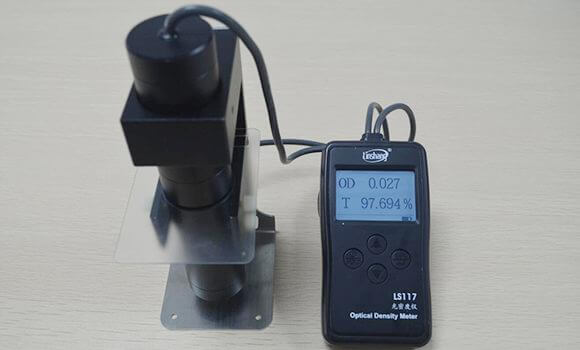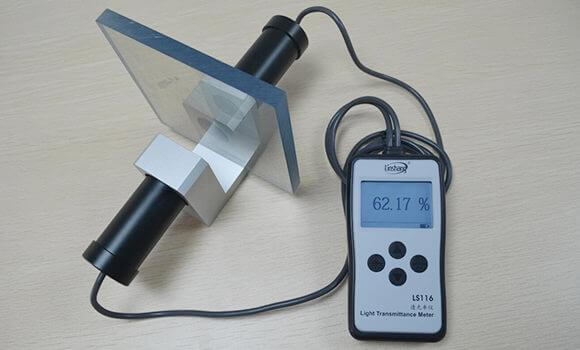How to Choose Transmittance Tester?
The transmittance tester is also called transmittance meter, light transmittance meter, etc. It is mainly suitable for the measurement of light transmittance of various transparent materials, such as films, organic glass, plastic products and automotive glass. It is a portable test instrument. It is widely used in manufacturing, quality inspection, product inspection, finished product display and other occasions.
I. Light transmittance test in different industries
Nowadays, in many different industries, there is a demand for light transmittance testing.
-
Glass manufacturing industry
In the glass industry, with the continuous improvement of industrial technology, glass products are widely used in everyone's daily life. When people choose glass, an important indicator of whether the lighting quality is good is light transmittance. The transmittance value of glass can be accurately measured using a transmittance tester.
-
Plastics and organic glass industry
Plastics such as PVC, PMMA and film packaging that are common in life are widely used in many industries such as building materials, packaging and medicine. Due to the different requirements of the industry for detecting light transmittance, the light transmittance of the corresponding finished products will also be different.
-
Automotive glass industry
For another example, the light transmittance of automobile glass is also subject to corresponding national regulations. According to the provisions of Article 11.5.7 of the "Safety Technical Conditions for Motor Vehicle Operation": the light transmittance of the front glass of the van cannot be less than 70%, while the side windshield light transmittance should not be less than 50%. Colored paper or heat-insulating paper with opaque and any reflective materials should not be posted. It can be seen that testing with a transmittance tester in different industries is essential.
II. How to choose the transmittance tester in different industries?
The products that need to test the light transmittance have different shapes, the choice of the transmittance tester is also different. As a manufacturer of transmittance testers, Linshang Technology recommends different transmittance testers depending on the test materials. Customers can choose according to the following categories:
1. Transmittance tester used in the glass industry
For testing translucent and transparent glass such as tempered glass, wire glass, hollow glass, hot-bent glass, laminated glass, etc., it is recommended to use the glass transmittance tester LS116, the instrument accuracy is up to ± 1%. The thickest material that can measure is about 100mm regular transmission material. The light transmittance can be measured up to 99.8%, (most common transmittance testers test data will display 100% when the real data exceeds 96%). This transmittance tester has the highest accuracy in the industry.
For testing opaque glass such as frosted glass, embossed glass, dimming glass, ice flower glass, etc., it is recommended to use the transmittance tester LS117, which use the diffuse transmission principle and can replace the integrating sphere test method. During the instrument test, the optical density value and the light transmittance value can be tested simultaneously.
2. Transmittance tester used in the plastics industry
Plastic products are not only diverse in appearance, but also different in color. Before choosing a transmittance tester, the customer must first confirm whether the sample is transparent or translucent. The method of confirmation is to put the sample in front of your eyes and look at your fingers or objects through the sample. If the edges are clear, like glass, it is transparent. If the edges are blurred, it is a misty material.
As mentioned above, the transparent and transparent PC board, PMMA, PVC and other plastic materials can be tested using the transmittance tester LS116. If you are testing translucent materials (fogged materials, matte materials), such as lampshades, diffusers, aluminum coatings, opalescent materials, etc., it is recommended to use the transmittance tester LS117.
III. FAQ of Transmittance Tester
-
1. Why is the transmittance tester designed with parallel light path for testing thick glass?
This is because the glass is condensing. When the point light source passes through the glass, the detector will receive the light intensity that could not be received because of the condensing performance of the glass, which makes the test data larger; The parallel light path is normal incidence. At the junction of glass and air, the direction of the light source does not change, so the received light intensity is equal to the actual light intensity passing through the glass. Therefore, the data of the transmittance tester using the parallel light path is more accurate.
-
2. Which transmittance tester is better for measuring the front windshield of a car?
Both LS110 and LS116 transmittance testers can be used. The two probes of the LS116 are connected, we generally recommend the LS110. The main and auxiliary units of the LS110 split transmittance tester are separated, no connection line design, with laser alignment function. The instrument contains three independent transmittance test modules, the data obtained is the average value of three channels. The convenience of use and data stability are relatively better.
-
3. Why is the LS117 transmittance tester so expensive?
The LS117 transmittance tester adopts the principle of diffuse transmission, which simultaneously measures the transmittance and optical density. It can also measure the transmittance of semi-transparent materials such as opalescent, mist, frosted and optical density of low-transmittance materials such as aluminum coating.
Most of the transmittance testers on the market can only measure the light transmittance of regular transmission materials. The transmittance of the diffuse transmission material must be measured with an instrument based on the principle of diffuse transmission to obtain accurate data. And the test data of the LS117 transmittance tester is the same as the X-rite 341C of X-Rite, but the price is much more affordable.
-
4. Can the transmittance tester be used in high temperature environment?
The Linshang transmittance tester is suitable for use in normal temperature environment.
-
What kind of light source does the transmittance tester conform to the CIE photopic luminosity function?
The Linshang transmittance tester uses LED white light source. The combination of light source + vision function filter + detector meets the CIE vision function standard.
- Linshang Insulated Glass Unit Measuring Tools
- Spectacle lens anti-blue light detection---blue-violet light transmittance meter
- Measurement of Optical Density
- Difference of LS116 Transmission & LS117 OD Meter
- Difference between LS116 and LS117 Light Transmittance Meter
- What’s the Difference Between Point Light and Parallel Light Transmittance Meter

